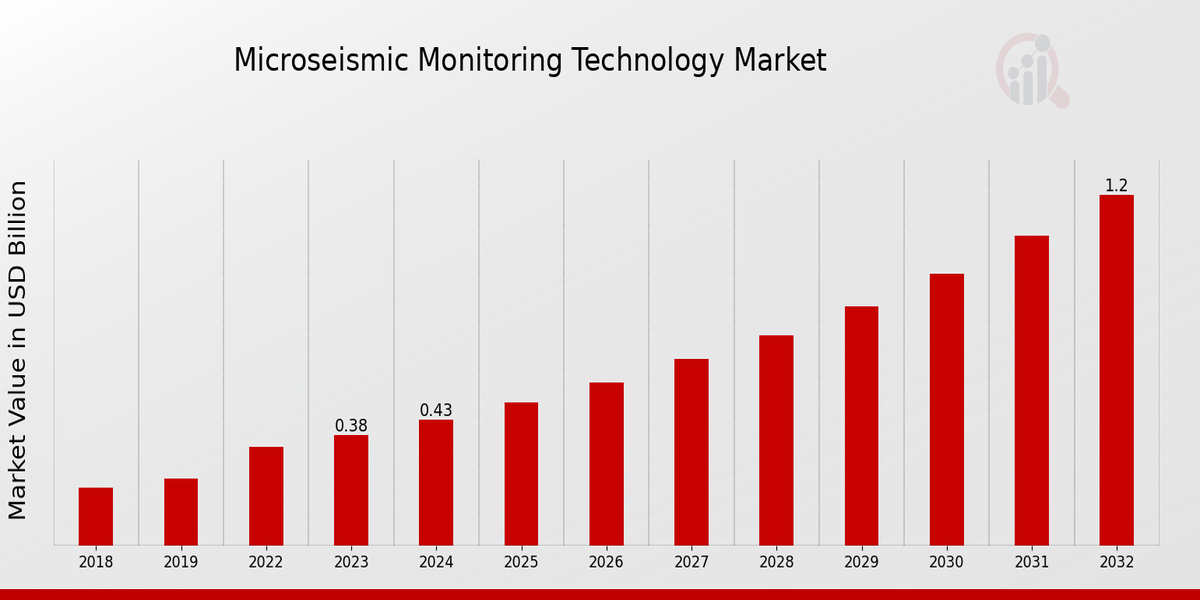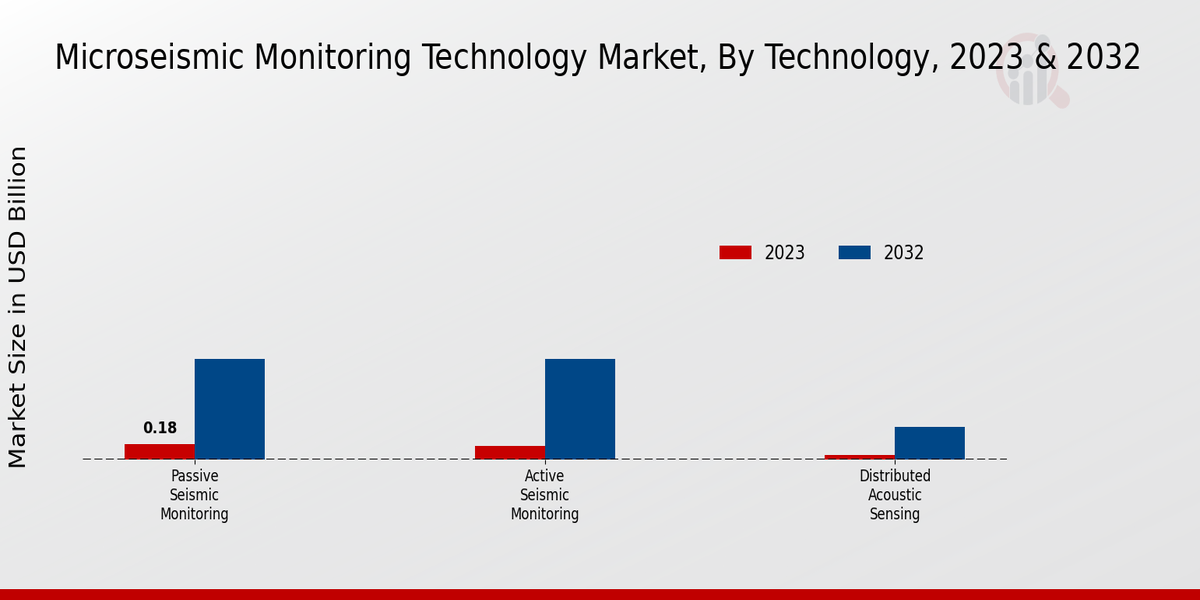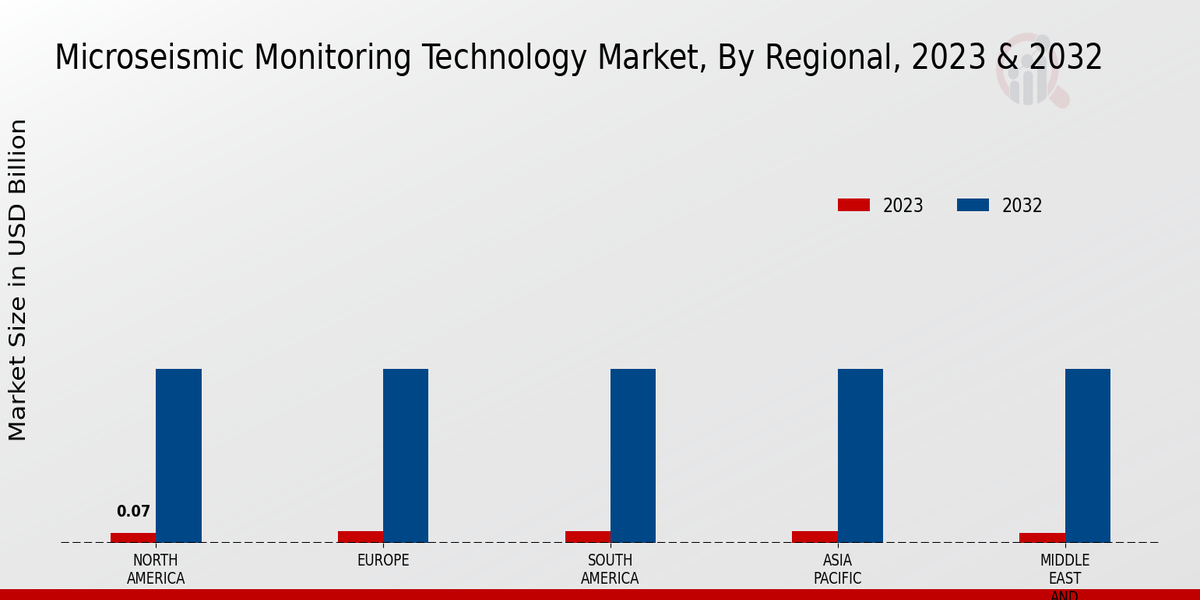Global Microseismic Monitoring Technology Market Overview
As per MRFR analysis, the Microseismic Monitoring Technology Market Size was estimated at 0.34 (USD Billion) in 2022. The Microseismic Monitoring Technology Market Industry is expected to grow from 0.38(USD Billion) in 2023 to 1.2 (USD Billion) by 2032. The Microseismic Monitoring Technology Market CAGR (growth rate) is expected to be around 13.55% during the forecast period (2024 - 2032).

Source: Primary Research, Secondary Research, MRFR Database and Analyst Review
Key Microseismic Monitoring Technology Market Trends Highlighted
Recognizing the growing concerns over fracking-induced seismicity and the need to monitor mining operations, the demand for microseismic monitoring technology is escalating. Key market drivers include stringent environmental regulations, rising awareness of microseismic risks, and the increasing use of fracking techniques.
Opportunities for market expansion lie in developing cost-effective and portable systems, enhancing real-time monitoring capabilities, and integrating advanced data analytics and machine learning algorithms to optimize threat detection and mitigation. Trends in the market include a shift towards wireless and autonomous monitoring systems, the adoption of cloud-based data management platforms, and the integration of geospatial imaging technologies.
Microseismic Monitoring Technology Market Drivers
-
Increasing demand for real-time monitoring of subsurface activities
The need for subsurface activities. The growing need for the real-time monitoring of subsurface activities, such as hydraulic fracturing, carbon capture and storage, and geothermal energy exploration, drives the demand for this technology. Understanding the operating environment. The location and magnitude of these samples are analyzed to assess the fracturing process, reservoir performance, and potential risks. With the help of this technology and the information obtained from it, the operators can learn more about the formation structure and whether formation occurrence needs to be adversarial.
Technological advancements in sensor technology and data processing algorithms
In the modern world, the development of sensor technology and data processing algorithms allows for substantially improving the performance of microseismic monitoring systems. The availability of high-sensitivity sensors and applications powered by distributed acoustic sensing drives the growth of precision and accuracy with which microseismic events can be detected and located. Furthermore, the introduction of machine learning and artificial intelligence allowed the development of models that would be able to automatize data processing and analysis.As a result, microseismic monitoring has become increasingly popular in various industries.
Growing awareness of the benefits of microseismic monitoring
The Microseismic Monitoring Technology Market industry is growing due to the increasing awareness of its benefits. This is because many operators use this monitoring to optimize subsurface technologies, avoid associated risks, and make better decisions in the process. Moreover, most industries use this technology since they have realized its real-time capabilities in gaining insights into subsurface activities. Therefore, monitoring technology is currently used in different sites, such as hydraulic fracturing, carbon capture and storage, geothermal energy exploration, and mining, amongst other areas.As such, the benefits are becoming visible as monitors are becoming more popular in different industries.
Microseismic Monitoring Technology Market Segment Insights
Microseismic Monitoring Technology Market Technology Insights
The Microseismic Monitoring Technology Market is segmented by technology into Passive Seismic Monitoring, Active Seismic Monitoring, and Distributed Acoustic Sensing – DAS. The passive seismic monitoring segment held the largest market share in 2023 and is expected to continue to dominate the market in the coming years. Passive Seismic Monitoring is extensively used in various types of applications, such as reservoir monitoring and evaluation of hydraulic fracturing and earthquakes. Moreover, it is the most commonly used technology by several end-user industries.
Over the forecast period, the Active Seismic Monitoring segment is anticipated to grow at the highest CAGR. The seismic events need to be recorded in real-time to ensure safety and smooth operations in the mining, construction, and oil and gas industries. The technological advancements in the actively monitoring microseismic events segment are expected to encourage the growth of the microseismic monitoring technology market. Distributed Acoustic Sensing – DAS is anticipated to be a promising segment in the Microseismic Monitoring Technology Market.
Due to its high spatial resolution and the ability to monitor continuously, the technology is found to offer multiple advantages. It emerges as a cost-effective technology, effectively cutting down the overall installation cost required to gather detailed information. The major factors driving the growth of the Microseismic Monitoring Technology Market are increased seismic monitoring due to the growing demand for ensuring safety and efficiency in the operations, technological advancements resulting in the development of more reliable and cost-effective monitoring solutions, and increased demand from several end-use industries, such as oil and gas, mining, and geotechnical engineering. Additionally, the market is anticipated to record a growth in the demand for monitoring technology over the forecast period on account of the increasing investments in infrastructure development.

Source: Primary Research, Secondary Research, MRFR Database and Analyst Review
Microseismic Monitoring Technology Market Application Insights
The application segment of the Microseismic Monitoring Technology Market is of considerable relevance, and it provides a broader understanding of the industry’s operations. This market share is dominated by the Oil and Gas Exploration and Production segment as the need to enhance reservoir characterization, monitoring, and production optimization. In 2023, the market for Microseismic Monitoring Technology in the Oil and Gas Exploration and Production segment was around USD 0.22 billion, and the demand is forecasted to expand at a CAGR of 14.2% between 2024 and 2032 to reach USD 0.59 billion by 2032.
By contrast, the mining and geotechnical engineering segment is also a market driver as microseismic monitoring is applied to evaluate rock stability, support excavation monitoring, and facilitate the utilization process. In this regard, this market is to grow at a stable pace and is to reach USD 0.28 billion by 2032. The niche application segments such as Carbon Capture and Storage, Geothermal Exploration and Production, and Hydrological and Environmental Monitoring are to offer new opportunities.
The former is aimed to employ microseismic monitoring to facilitate the evaluation of adopted CO2 storage sites; the latter is to utilize this instrument to map reservoirs and assess their potential, while the latter is to assist in evaluating groundwater resources and applying appropriate strategies to manage and utilize them.
Microseismic Monitoring Technology Market Deployment Type Insights
The Microseismic Monitoring Technology Market is segmented by deployment type into permanent monitoring, temporary monitoring, continuous monitoring, and intermittent monitoring. The permanent monitoring segment is expected to hold the largest market share in 2023, owing to the increasing demand for real-time monitoring of critical infrastructure and the need for continuous data collection for long-term analysis.
The temporary monitoring segment is expected to grow at a significant rate during the forecast period due to the rising adoption of microseismic monitoring for short-term projects such as exploration and production activities. The continuous monitoring segment is expected to witness steady growth, driven by the need for continuous monitoring of high-risk areas such as mines and dams. The intermittent monitoring segment is expected to grow at a moderate rate, owing to the increasing use of microseismic monitoring for periodic monitoring of infrastructure and the environment.
Microseismic Monitoring Technology Market Data Acquisition Method Insights
The Microseismic Monitoring Technology Market is witnessing significant growth owing to the increasing adoption of microseismic monitoring in various industries, including oil and gas, mining, and civil engineering. The Data Acquisition Method segment plays a crucial role in the market, influencing the overall Microseismic Monitoring Technology Market revenue. Surface Acquisition, Borehole Acquisition, and Downhole Acquisition are the primary data acquisition methods used in microseismic monitoring.
Surface Acquisition involves placing sensors on the ground surface to detect seismic waves generated by subsurface activities. This method is commonly used in exploration and production activities in the oil and gas industry, as it provides a cost-effective way to monitor large areas. Borehole Acquisition, on the other hand, involves placing sensors in boreholes drilled into the subsurface.
It offers higher data quality and resolution compared to Surface Acquisition, making it suitable for detailed monitoring of specific areas or depths. Downhole Acquisition involves placing sensors directly into the production zone or target formation. This method provides the highest level of data quality and resolution, but it is also the most expensive and complex to implement. The choice of data acquisition method depends on factors such as the specific application, depth of interest, and budget constraints.
Microseismic Monitoring Technology Market Regional Insights
The regional segmentation of the Microseismic Monitoring Technology Market offers valuable insights into the geographical distribution of market growth. North America is anticipated to dominate the market in 2024, capturing over 35% of the global revenue share. This dominance can be attributed to the presence of major oil and gas exploration and production companies in the region.
Europe is expected to follow closely with a significant market share, driven by growing investments in renewable energy sources and the adoption of microseismic monitoring for geothermal exploration. The Asia-Pacific (APAC) region is projected to witness notable growth, primarily due to the increasing demand for energy resources and the expansion of the oil and gas industry in the region. South America, the Middle East, and Africa (MEA) are also expected to contribute to the overall market growth, albeit to a lesser extent than the other regions.

Source: Primary Research, Secondary Research, MRFR Database and Analyst Review
Microseismic Monitoring Technology Market Key Players And Competitive Insights
Key Microseismic Monitoring Technology Market players such as Schlumberger Limited and Halliburton Company are driving their expansion by pursuing a series of acquisitions and forming partnerships with other players in the market. Top Microseismic Monitoring Technology Market players aim to leverage innovative technologies to enhance the accuracy, reliability, and cost-effectiveness of their products and often expand these efforts through acquisitions or partnerships with technology companies.
The industry is poised to experience robust growth, driven by increased demand for real-time subsurface monitoring among oil and gas operators, mining companies, and the geothermal industry across the globe. A main rival firm in the Microseismic Monitoring Technology Market is Schlumberger Limited. The Texas-based company offers a full portfolio of microseismic monitoring solutions, including sensors, acquisition systems, and software. Schlumberger leads the market, in particular, with in-depth experience in advanced seismic imaging and interpretation and is one of the largest suppliers of microseismic monitoring technologies across the globe.
Schlumberger’s focus on research and development is a distinguishing feature, as the company invests continuously in developing a better understanding of sub-surface reservoirs and new technologies to enhance the performance of its existing products. Another important Microseismic Monitoring Technology Market player is Halliburton Company. The Texas-headquartered company provides a range of microseismic monitoring services, including data acquisition, processing, and interpretation.
Halliburton has developed and marketed proprietary systems for real-time underground sub-surface measurement. To develop its product and service offerings, the company leverages highly advanced technologies for reservoir characterization and production optimization. Leading supplier of microseismic monitoring solutions to the oil and gas and geothermal industry, the company continues to seek ways to expand this capability.
Key Companies in the Microseismic Monitoring Technology Market Include
- CGG
- Keeleco Seismic Monitoring
- Sercel
- Weatherford Internation
- Fugro Group
- Schlumberger Limited
- Halliburton
- Geokon, Inc.
- Ion Geophysical
- Baker Hughes
- HiTec Seismic Ltd.
- Stresscheck Monitoring Ltd.
- MicroSeismic, Inc.
- Microseismic Inc.
- INOVA Geophysical
Microseismic Monitoring Technology Market Industry Developments
Recent developments in the Microseismic Monitoring Technology Market include the growing adoption of fiber optic-based systems, advancements in data analytics and machine learning algorithms, and increasing investments in research and development. For instance, in 2023, Schlumberger introduced a new fiber optic-based microseismic monitoring system called OPTIMA, which offers enhanced data quality and real-time monitoring capabilities.
Additionally, companies are focusing on developing integrated solutions that combine microseismic monitoring with other technologies, such as geophysics, reservoir simulation, and production optimization. The integration of these technologies enables more comprehensive reservoir characterization and improved decision-making for operators.
Microseismic Monitoring Technology Market Segmentation Insights
-
Microseismic Monitoring Technology Market Technology Outlook
- Passive Seismic Monitoring
- Active Seismic Monitoring
- Distributed Acoustic Sensing (DAS)
-
Microseismic Monitoring Technology Market Application Outlook
- Oil and Gas Exploration and Production
- Mining and Geotechnical Engineering
- Carbon Capture and Storage
- Geothermal Exploration and Production
- Hydrological and Environmental Monitoring
-
Microseismic Monitoring Technology Market Deployment Type Outlook
- Permanent Monitoring
- Temporary Monitoring
- Continuous Monitoring
- Intermittent Monitoring
-
Microseismic Monitoring Technology Market Data Acquisition Method Outlook
- Surface Acquisition
- Borehole Acquisition
- Downhole Acquisition
-
Microseismic Monitoring Technology Market Regional Outlook
- North America
- Europe
- South America
- Asia Pacific
- Middle East and Africa
| Report Attribute/Metric |
Details |
| Market Size 2022 |
0.34(USD Billion) |
| Market Size 2023 |
0.38(USD Billion) |
| Market Size 2032 |
1.2(USD Billion) |
| Compound Annual Growth Rate (CAGR) |
13.55% (2024 - 2032) |
| Report Coverage |
Revenue Forecast, Competitive Landscape, Growth Factors, and Trends |
| Base Year |
2023 |
| Market Forecast Period |
2024 - 2032 |
| Historical Data |
2019 - 2023 |
| Market Forecast Units |
USD Billion |
| Key Companies Profiled |
CGG, Keeleco Seismic Monitoring, Sercel, Weatherford International, Fugro Group, Schlumberger Limited, Halliburton, Geokon, Inc., Ion Geophysical, Baker Hughes, HiTec Seismic Ltd., Stresscheck Monitoring Ltd., MicroSeismic, Inc., Microseismic Inc., INOVA GeophysicalTop of FormBottom of Form |
| Segments Covered |
Technology, Application, Deployment Type, Data Acquisition Method, Regional |
| Key Market Opportunities |
Growing adoption of unconventional oil and gas exploration Increasing demand for real-time monitoring of underground phenomena Advancements in sensor technology Integration with artificial intelligence and machine learning Expanding applications in mining and civil engineering |
| Key Market Dynamics |
Growing oil and gas production Rise in RampD investment. Technological advancements Increasing environmental concerns Surge in demand for real-time monitoring |
| Countries Covered |
North America, Europe, APAC, South America, MEA |
Frequently Asked Questions (FAQ) :
In 2023, the Microseismic Monitoring Technology Market was valued at approximately 0.38 billion USD.
The market is projected to grow at a CAGR of 13.55% from 2024 to 2032.
North America is expected to hold the largest market share over the forecast period due to the presence of major oil and gas companies and the increasing adoption of microseismic monitoring technology in the region.
Microseismic monitoring technology is primarily used in the oil and gas industry to monitor the safety and stability of oil and gas reservoirs during hydraulic fracturing operations. It is also used in mining, geothermal, and construction industries.
Key competitors in the Microseismic Monitoring Technology Market include Schlumberger, Halliburton, Baker Hughes, and Weatherford International.
The growing demand for oil and gas, increasing safety concerns related to hydraulic fracturing operations, and technological advancements in microseismic monitoring systems are driving the growth of the market.
Challenges faced by the market include high costs associated with microseismic monitoring systems, the need for skilled professionals, and regulatory restrictions in certain regions.
Emerging trends in the market include the development of real-time microseismic monitoring systems, the integration of machine learning and artificial intelligence, and the use of microseismic monitoring data for reservoir characterization and production optimization.
Key opportunities for market growth include the expansion of microseismic monitoring technology into new applications, such as geothermal and mining, and the development of cost-effective and portable microseismic monitoring systems.
Potential risks to market growth include economic downturns, fluctuations in oil and gas prices, and the development of alternative technologies for reservoir monitoring.

















